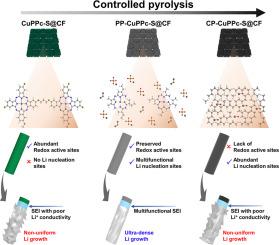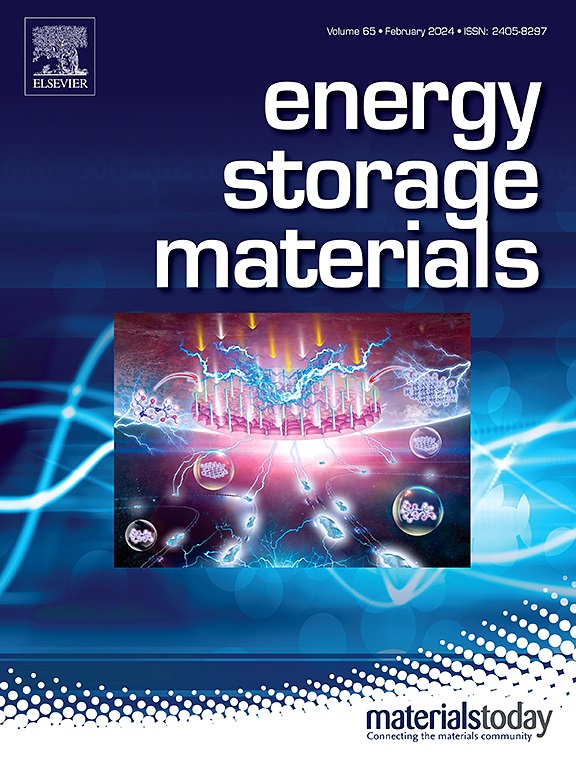Ultra-high Lithium Reversibility Achieved by Partially Pyrolyzed Polymeric Copper Phthalocyanines for Superior Anode-free Lithium Metal Batteries
IF 18.9
1区 材料科学
Q1 CHEMISTRY, PHYSICAL
引用次数: 0
Abstract
Anode-free lithium metal batteries (AFLMB) can maximize the energy density by eliminating active materials, conductive agents and binders from the anode. However, intrinsic issues of lithium (Li) metal anodes, such as non-uniform Li growth, large volume changes and unstable solid electrolyte interphase (SEI), become much pronounced, rapidly degrading the cyclability of AFLMB. Herein, we present a superior three-dimensional (3D) AFLMB host, which takes advantage of partially decomposed polymeric copper phthalocyanines bridged by di-thioether linkers (CuPPc-S) as an ultra-thin surface coating layer. By intensive material characterizations alongside in-situ thermal gravimetric analyses coupled with mass spectrometer, we demonstrate that our controlled pyrolysis results in the formation of partially pyrolyzed CuPPc-S (PP-CuPPc-S), where intrinsic redox active sites of CuPPc-S and newly formed ultra-fine Cu–S inorganic compounds co-exist. The preserved redox active sites can not only improve lithiophilicity, but also facilitate the decomposition of TFSi⁻, inducing abundant LiF in the SEI, while Cu–S compounds can serve dual roles as active Li nucleation sites and ionically conductive Li2S inducer in the SEI. Benefiting from these components, PP-CuPPc-S coated carbon fiber (PP-CuPPc-S@CF) can form a multifunctional SEI and induce dense Li nucleation, achieving the stable operation of 1000 cycles with a LiFePO4 cathode in AFLMB configuration.

求助全文
约1分钟内获得全文
求助全文
来源期刊

Energy Storage Materials
Materials Science-General Materials Science
CiteScore
33.00
自引率
5.90%
发文量
652
审稿时长
27 days
期刊介绍:
Energy Storage Materials is a global interdisciplinary journal dedicated to sharing scientific and technological advancements in materials and devices for advanced energy storage and related energy conversion, such as in metal-O2 batteries. The journal features comprehensive research articles, including full papers and short communications, as well as authoritative feature articles and reviews by leading experts in the field.
Energy Storage Materials covers a wide range of topics, including the synthesis, fabrication, structure, properties, performance, and technological applications of energy storage materials. Additionally, the journal explores strategies, policies, and developments in the field of energy storage materials and devices for sustainable energy.
Published papers are selected based on their scientific and technological significance, their ability to provide valuable new knowledge, and their relevance to the international research community.
 求助内容:
求助内容: 应助结果提醒方式:
应助结果提醒方式:


